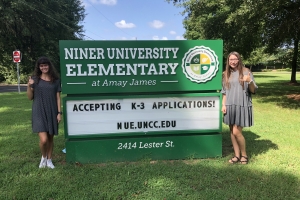
“When people think about research, they may not be thinking about what we do as artists and designers… it might just look a little different than what people are accustomed to,” says CoA+A Dean Brook Muller. Undergraduate students from across our College are experiencing the wide range of arts and design research through participation in faculty research initiatives. By engaging in innovative projects with their faculty mentors, students are making discoveries, contributing knowledge, and furthering their creative capacity and academic success. Check out what a few of our students are working on!
Optimizing facilities post-pandemic given human behavior studied through VR and Eye-tracking
Faculty mentor Dr. Kyoung Hee Kim, AIA, NCARB (Architecture); Dr. Churlzu Lim and Dr. Simon Hsing (Systems Engineering)
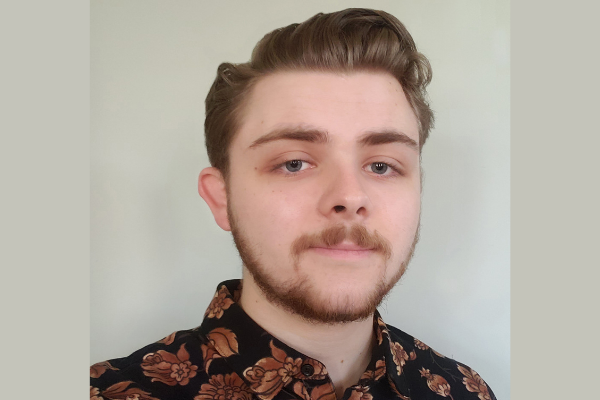
Jonathan Joles, Bachelor of Architecture; minor in Computer Science '23
Hometown: Mint Hill, NC
Post-undergrad aspirations: My hopes are to continue into a Masters in Architecture and Desgin Computation. I would also like to start building computer keyboards for others and possibly start working in a smaller firm.
Describe the research activity you are helping with.
The current project and research is a data-driven study on how to optimize facilities following the pandemic studying the behavior of people through VR and Eye-tracking software. The general idea is to research the actions and behavior of people interacting in an office or facility. How would they react given a specific situation and a specific hallway size? Do they walk around the long way to get to their office with small halls? Or do they walk straight toward their destination? This could entail dealing with a group of students or someone in a wheelchair. The goal is to study their reaction through movement, eye movement, and other data. The study is done through a model in which the width and length of offices and hallways change while keeping the outside boundary of the office consistent. The model work is done through Rhino and runs in Unity 2019, while combined with a VR headset, VR Treadmill, and Eye-tracking software.
How does your mentor, Kyoung Hee, make the experience meaningful and successful?
Having Kyoung hee as a mentor has been an extremely great opportunity and has helped push my studies not only as a student but as a studying architect. She has done an awesome job of helping me focus on what is really important and what is the practical approach to some of the problems in the work. While she respects my opinion and decision-making throughout the processes allowing me to have a real connection to the project.
What are you learning?
What I have been learning since the start of the project has been a lot of computer programs such as Unity, Blender, Maya, and plenty of software integration. One of the many reasons I wanted to become an architect was because I live for modeling and design software – it is what I'm good at and what I love. Additionally, working as a research assistant has also taught me what it is like to work in the world of research. A lot of focus was on how to minimize the number of elements in a study and how to refine your research.
What advice would you give other undergraduates who are considering participating in a faculty-led research opportunity?
I think the best advice I can give to anyone is if you're thinking about working for a professor, go for it. It can be challenging, but it also helps you find what you are interested in and what the limits and possibilities of the work are. Talk with some of the other students and hear their experiences with different professors. Make sure that the workload is for you. It will test your time management and will help with it too.
S.E.L. in Dance Education
Faculty mentor Dr. Marissa Nesbit
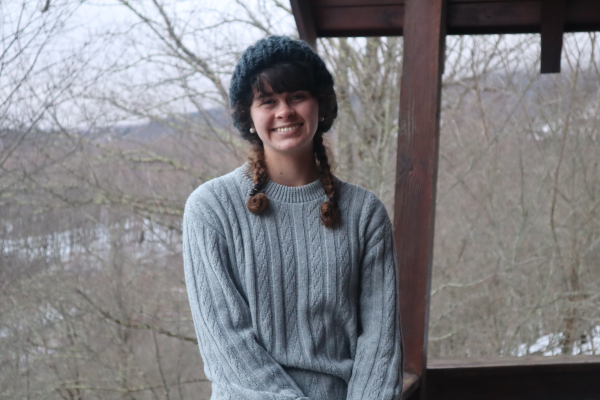
Maggie Church, BA in Dance with a Concentration in Dance K-12 Education '23
Hometown: Harmony, NC
Post-undergrad aspirations: Dance Educator in a public school system; Dance Teacher at a studio.
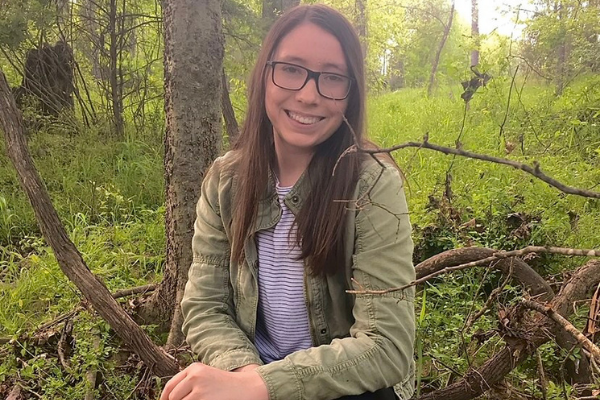
Alyssa Gray, BA in Elementary Ed and BA in Applied Dance with K-12 teaching licensure '23
Hometown: Mount Pleasant, NC
Post-undergrad aspirations: My goal is to move to the coast and teach kindergarten at an at-risk school.
Describe the research activity that you are doing.
Maggie: At Niner Elementary School we are teaching students dance lessons in which we incorporate Social Emotional Learning (SEL) skills as well as address curriculum standards in arts education. We are designing, implementing, and refining curriculum modules, identifying certain dance concepts and activities that will help with the development of SEL skills for the students.
Alyssa: Dr. Nesbit, Maggie Church, and I are collaborating together to find ways to integrate Social Emotional Learning (SEL) and dance for elementary students. Some of my responsibilities include assisting with planning and teaching pilot lessons at Niner Elementary and collecting documentation regarding the project.
Why does this work appeal to you?
Maggie: This work appeals to me because two of my favorite things are dancing and working with kids. Something that is important to me is how kids are feeling and handling life. Learning about this research project, and how it will combine dance, kids, and SEL, I knew that I wanted to be part of it. It is important to me to know that I am not just teaching a dance lesson, but rather I am using dance as a way to connect with students and help them to develop skills that will be beneficial in their lives.
Alyssa: This work is important to me because it is a great opportunity for me as a student to learn and grow. I want to teach at an at risk elementary school, where students may have severe emotional or behavioral problems, special needs, low academic performance, or low socioeconomic status. I hope I can take what I have learned from my work. specifically using dance and SEL, and apply it to my classroom when I become a teacher.
How does your mentor make the experience meaningful and successful?
Maggie: Dr. Nesbit makes this experience meaningful and successful by bringing a positive outlook and enthusiasm for the work. She makes sure she is not just leading the project, but she also makes sure Alyssa and I are a part of the project as well. By this I mean she wants to hear our input in discussions and ideas for the project and planning. I have really enjoyed working with a professor that has a heart for children and dance, and I have learned and will continue to learn a lot from Dr. Nesbit.
Alyssa: Dr. Nesbit has made this experience meaningful and successful offering lots of support and guidance along the way. We have only just begun our research project. However, I can tell that she is going to be an amazing mentor, and I am going to learn a lot working with her.
What are you learning?
Maggie: I am learning about the importance of working as a collaborative team, making sure I am both giving and receiving thoughts and ideas throughout different parts of the project. I am learning how to teach and work directly with students in a classroom. I am also learning about teaching meaningful dance lessons.
Alyssa: Right now, I am learning what SEL is and how it can be incorporated in a dance class. I am also learning personally how to be a better leader and teacher.
What advice would you give other undergraduates who are considering participating in a faculty-led research opportunity?
Maggie: My advice would be to take the opportunity to participate in a faculty-led research project. It is a great way to broaden your outlook on life. You are able to be a part of something that not only benefits you, but also benefits other people as well.
Alyssa: I would say go for it! I was very nervous at first when I decided to participate in a faculty-led research project. However, once I started meeting and talking with Dr. Nesbit, as well as started teaching at Niner Elementary, it has been an amazing experience and opportunity, and I absolutely love it.
Architectural History and Exhibition Design
Faculty mentor Dr. Emily Makas
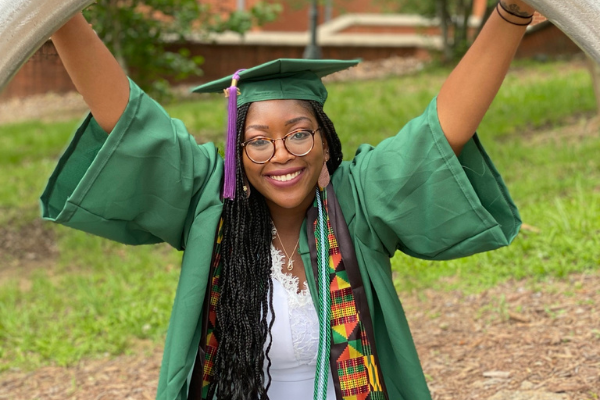
Sierra Grant, Master of Architecture '23; BA in Architecture '21
Hometown: Stroudsburg, PA
Career aspirations: Hopefully finding a job that combines architecture, graphic design, and public art.
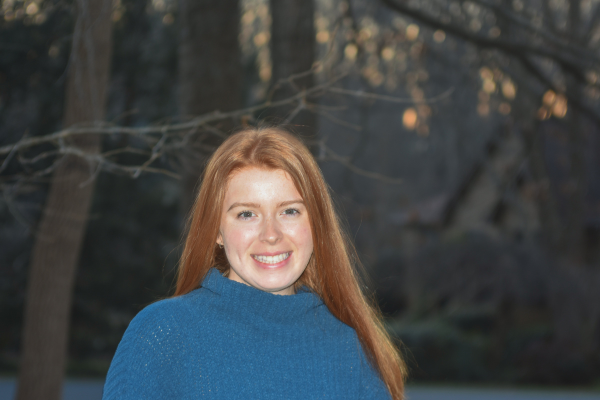
Hometown: Hickory, NC
Career aspirations: I want to practice architecture and eventually continue my education to earn a Ph.D. in Architectural History/Theory.
Describe the research activity that you are doing.
Sierra: I have been working to help develop the exhibition, Container/Contained: Phil Freelon - Design Strategies for Telling African American Stories. Phil Freelon was a well-respected but underappreciated African American architect who passed away in 2019. Freelon and his firm, The Freelon Group, focused on the design of museums, cultural centers, libraries, universities, and other public buildings. My research has two parts: first, to study the role of color and pattern in Freelon's design, and second, to use Freelon's work as inspiration for the graphic design of an exhibition exploring and analyzing his work that will then be displayed at the Harvey B. Gantt Center in Charlotte and the North Carolina Museum of Art in Raleigh.
Kelly: I assisted Emily Makas and Greg Snyder in curating information for the Phil Freelon exhibit opening at the Gantt Center in late October. More specifically, I helped develop metamorphosis models that portrayed Freelon's design concept to the final building. The models are designed for the 3d printer, so I explored the connections between the design methods and their translation into the printed models.
Why does this work appeal to you? Why is this work important to you?
Sierra: Being in the School of Architecture is very exciting, but it's all imaginary (in other words - nothing we design ever gets built). So, designing the graphics for the Freelon exhibition appeals to me not only because Phil Freelon was an amazing artist, teacher, and architect, but because we are getting to create something for people to actually visit and experience. We get the privilege to tell the story of Phil Freelon and his work through multiple forms of physical and graphic representation; the goal is to show how Freelon used color and design to express cultural identity, history, and connections to the community.
Kelly: Phil Freelon designed the Smithsonian Museum of African American History and Culture in Washington DC, numerous libraries, and public-use buildings throughout the US; however, there has been no substantial, critical analysis of his work. This project aims to highlight his designs and create a name for an architect that truly designs for the community. It's important that architectural analysis is distributed among a variety of architects, especially minorities in the field, so future generations will have role models and see themselves in the profession.
How does your mentor make the experience meaningful and successful?
Sierra: Throughout this entire process, Dr. Makas has been incredibly helpful and knowledgeable. We have a pretty large team of designers from the School of Architecture working with us as well on the exhibition, which has allowed me to take a leadership role on the Graphics Team, and Dr. Makas has been amazing in helping me navigate and overcome the challenges that come along with this.
Kelly: Emily led us through weekly meetings and explained the importance of each component of the project. For the Summer Research program, she took time to check in with our personal projects for the program. I studied the environmental impact of Freelon's work, and she guided me with advice from her own experience presenting research. Emily creates an atmosphere that makes me interested in the work we do and telling Phil Freelon's story.
What are you learning?
Sierra: I have learned so much working on this project since I have been a part of the team for over a year now, but overall creating for this exhibition has allowed me to really enhance my graphic design, leadership, and teamwork skills.
Kelly: I learned so much about design and the way different components of a building can maintain consistency as they culminate to adhere to the building's parti. Throughout the summer, I learned so much from my peers by sharing knowledge because we were all in different architecture classes. The whole premise of the project is to study the work of Phil Freelon, and studying his design strategies encourage me to think about my own work differently.
What advice would you give other undergraduates who are considering participating in a faculty-led research opportunity?
Sierra: I think that participating in a faculty-led research project is a great opportunity, but it takes a lot of time and effort outside of your usual studies, so be prepared for that. It is important to try and stay organized and manage your time well - if you do that and work hard in the end the research that you do will be very rewarding.
Kelly: I would encourage other students to take the opportunity to do research with a faculty member and to ask questions. Professors have been in our shoes as students, and have continuously learned so much more about the subject. There are also times we learned together as we figured out a printing challenge for a model. Working with mentors through a problem collaboratively helped me in solving my own, individually, throughout the project.
Black Arts and Civic Engagement
Faculty mentor Tamara Williams
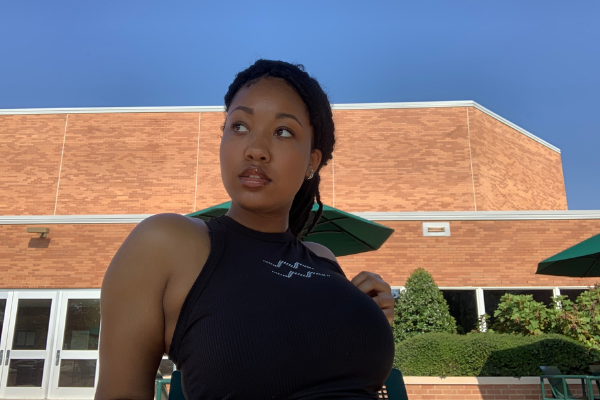
Nia Mills, BA in Dance with a concentration in Dance Education '23
Hometown: Raleigh, NC
Post-undergrad aspirations: choreographing and/or performing for major dance companies and mainstream artists
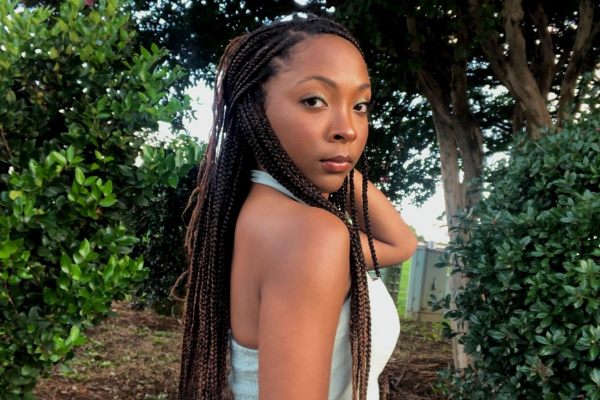
Briahna Waters, BA in Dance with a concentration in Performance, Choreography & Theory '23
Hometown: Hendersonville, NC
Post-undergrad aspirations: professionally perform, choreograph, and become an artistic director
Describe the research activity that you did this summer.
Nia: This past summer I participated in the Office of Undergraduate Research’s Summer Research Scholar Program here at UNC Charlotte. I was given the opportunity to work directly with Professor Tamara Williams. With her guidance, I spent time researching black histories and lineages in the Charlotte-Mecklenburg area. I explored significant events in the African American communities such as slave revolts and insurrections, as well as protests. Professor Williams was interested in seeing the links between these events and evidence of any dance practices by the enslaved people. Through learning about how the enslaved community utilized dance as a tool to communicate to one another and to respond to certain life experiences, I became interested in looking into other ways dance can be utilized. This led me to researching how dance has been used throughout history and the present day as a means of social justice.
Briahna: My research is focused on the ways that Black women are viewed and treated in society. More specifically, my focus is on Black women and police brutality, as they are often left out of the conversation, as well as Black women and mortality rates at birth and in general healthcare. As I study tragic stories of Black women, articles, interviews, photos, poetry, and the work of other Black artists in activism, I can use these sources as inspiration to create movement.
Why does this work appeal to you? Why is this work important to you?
Nia: I have always gravitated towards dance works that have a significant meaning behind them. I do believe as artists if you are given the opportunity to shed light on an important issue you should definitely take it! Activism doesn’t have to look a certain way or only be used in certain contexts. The work we do as artists is just as important as anyone else. Our voices should be heard too.
Briahna: This work is important to me because as an African American woman myself, I come face to face with the reality of these acts of discrimination. Not only this, but coming from a family full of African American women and children, I empathize with their constant struggles. I recognize that there are generations that come after me, and it is important that I actively seek to create a better world as everyone should. The more we speak and bring light to this issue, the closer we come to bringing about real change and hopefully in that, we can save lives.
How did your mentor make the experience meaningful and successful?
Nia: Professor Williams allowed me to freely explore my research interests. Whenever I had any ideas about where I wanted to take my research she would offer insightful feedback and additional helpful ideas.
Briahna: As my mentor, Tamara makes the experience more meaningful and successful as she is able to relate to the topic herself. That level of understanding provides a sense on comfortability that can’t always be found in others. She is a listening ear and constantly challenges me to think deeper about the topics that we discuss in class. Being in her class has inspired me to think more about the work I want to do in the future, mainly concerning that of disadvantaged communities.
What did you learn?
Nia: I learned how extensive research can really be, but also how rewarding and eye-opening it is as well. It can take hours to find something specific that you’re looking for, but when you find it opens up an entire world of never-ending knowledge. I learned so much about the city of Charlotte, the State of North Carolina, as well as dance and different forms and topics surrounding social justice.
Briahna: I am currently learning about the ways in which one should enter and exit a community as well as analyzing community work and how the arts can be involved. We’ve held discussions about how we can work in community and our interests while learning about different teaching techniques. We are also looking at the ways in which dance and activism can work together creating anti-racism work and in this, we have been examining Black dance.
What advice would you give other undergraduates who are considering participating in a faculty-led research opportunity?
Nia: Take the opportunity! I never thought I would be interested in research, but being a part of this program opened my eyes to a new avenue in the dance world. Definitely make sure that you are going to be working with a professor or faculty member that is conducting research in an area that you are interested in. Researching is A LOT of work, so you definitely want to make sure you’re enjoying it!
Briahna: I would advise other undergraduates who are considering participating in a faculty-led research opportunity to find a topic they are truly passionate about and to dig as deep as they can into their research. Everything that you learn as a result along with the change you can bring will make the experience that much more meaningful.
Design Gaze: Spatial Attractors Using Eye-Tracking Technology
Faculty mentor Peter Wong

Khalid Jasir Mills, Bachelor of Arts in Architecture '22
Hometown: Winston-Salem, NC
Post-undergrad aspirations: I want to obtain an internship and pursue my Master’s degree in Architecture. I would like to develop architecture that reflects the identity and needs of the community that it is being built in.
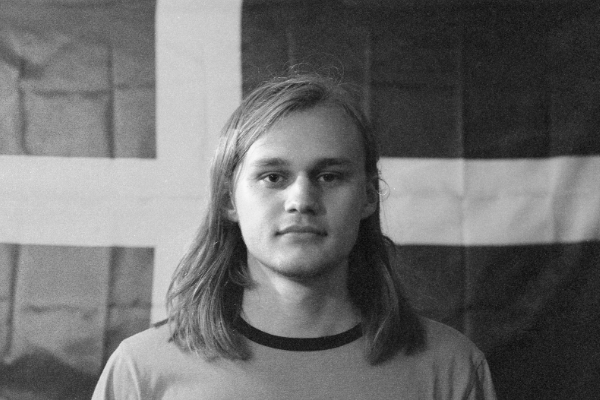
Luca Gillie, Bachelor of Arts in Architecture '22
Hometown: Durham, NC
Post-undergrad aspirations: Working in an architectural office for a year and then applying to graduate schools to do my M.Arch!
Describe the research activity you are helping with.
Jasir: I am assisting Associate Professor Peter Wong in researching the use of eye-tracking software data to inform the design of Interior Spaces and beyond. The result is to develop dwelling units for an affordable housing complex in Berlin. It is for an architectural competition for Bee Breeders Organization, which will be the vessel for experimenting with these findings.
Luca: I have been working with Peter Wong on designing architectural interiors to then record, extract, and interpret eye-tracking data to help inform the design of a series of affordable housing complexes in Berlin, Germany.
Why does this work appeal to you? Why is this work important to you?
Jasir: This work appeals to me because it involves focusing on investigating the human perception of interior spaces. I am interested in working on projects that are socially responsive. We have learned about the city of Berlin, its history and culture, and I have been tasked with generating diagrams, writing papers, and researching about Berlin and its housing typologies. Researching will be a necessary aspect as a future architect. This is excellent exposure to that type of work in any project that I may take on as a future design professional.
Luca: Designing spaces that interpret data and testing them gives an insight into some of the phenomenological underpinnings of architecture.
How did your mentor make the experience meaningful and successful?
Jasir: He still finds a way to teach us while we are working. He feels more like an instructor, and that support has been very evident from the jump. His research has allowed for a more focused objective, compared to some studio assignments that I’ve completed in the past. We really learned how to research effectively. Additionally, he has shown me how design can reflect the political, social, and cultural conversation of its surroundings. Especially in the context of Berlin, which has the literal history of federal occupation being present in the built form.
What did you learn?
Jasir: I am learning new methods and techniques from my fellow research assistants. Different perspectives have shown me new ways to pursue design solutions in my coursework and beyond. I love the experience of working on a team. It feels as if I am really able to put my skill set to the test. I have witnessed new strategies of drawing and analysis that can be utilized for prospective projects and/or work.
Luca: In addition to the actual content of the research, I am learning how a form of "architectural research" may be conducted.
What advice would you give other undergraduates who are considering participating in a faculty-led research opportunity?
Jasir: I would definitely recommend undergraduates to participate in a faculty-led research opportunity. They will learn skills that will help them grow professionally as well as creatively. It can craft their ability to ask questions in their discipline and conduct their own form of research in the future. Most importantly, it will show firsthand how their scholarly studies can be put into practice.
Luca: I would tell them that it definitely is a time commitment but that is strongly outweighed by what you get out of the research and the relationships that form from it.
Disparities in maternal healthcare among Black women presented through movement-based research
Faculty mentor Tamara Williams

Donna Thompson, BA in Applied Dance; BSBA in Finance with a concentration in Accounting '22
Hometown: High Point, NC
Post-undergrad aspirations: Either working as a public accountant or working in a financial analyst/advisor role. Either way, I'd like to later on in my career work in a finance role for a dance company or own a dance studio.
Describe the research activity you are helping with.
I am researching the disparities in maternal healthcare among Black women. This is a continuation of research that I previously did for an LBST class; however, this time, I am researching it from an activism stance as well as using it to create a dance solo using movement-based research.
Why is this work important to you?
This work is important to me because as a Black woman, I recognize how this disparity is unnecessarily taking the lives of many other Black women. For that reason, it is important for me to answer the question of why these unfavorable outcomes are happening and what can be done to minimize them.
How does your mentor, Tamara, make the experience meaningful and successful?
Professor Williams makes this experience meaningful and successful because she has provided us with many useful resources to use as a reference for how to approach activist research in dance. She has also allowed creative freedom for us to research an idea that is truly meaningful to us, and has shared with us many other Black women artists that are doing the same thing to bring about social change within their community.
What are you learning?
My research experience so far has taught me that it is okay to contribute emotional and personal experiences of others into research. Going into this project, I was under the assumption that research was solely based on "facts" and "evidence," when in reality, the personal experiences and emotional implications of others are valid "evidence." I have also learned how to apply research to create choreography. Before this semester, I had absolutely no clue how to bridge the sources that contribute to the research and an actual dance. I've been able to learn what the choreographic process consists of when basing it on research and how to incorporate and interpret the findings into something that is meaningful for a dance.
What advice would you give other undergraduates who are considering participating in a faculty-led research opportunity?
I would definitely encourage other undergraduate students to participate in faculty-led research! My advice would be to find something that you are very passionate about and to also find a faculty member that shares that same passion or that is willing to contribute to your passion. I would also encourage other students to take advantage of all that their faculty members may provide to them through their own experiences with research and connections that they have to develop your work.